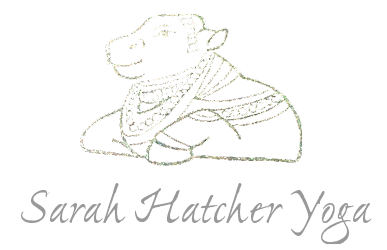Is Ashtanga Yoga a spiritual practice?

One of the dogs that I walk daily, The Bailers. He was wondering, "And Patanjali says what again about practice? Tell me, Sarah! Sadhana? Oooh, now what's that!? Walk!? When are we going? You wanna go NOW?"
There is much planning that goes on to maintain a daily ashtanga practice and many activities and hobbies are shifted or removed to keep your practice nourished. 'Practice' - if done daily and with effort over many years turns into what Vyasa would call a 'sadhana', or "one's specific daily spiritual practice" (Edwin Bryant).
Recently, a Philadelphia yoga friend of mine said, "ashtanga practice isn't a sadhana".
It may appear to someone who does not practice ashtanga vinyasa yoga that it may not be a 'spiritual practice' since the practice appears asana-based.
Practicing six days a week with the foundational elements of ashtanga:
vinyasa (breath-movement system),
breath (ujjayai),
bandhas (internal locks),
drishti (gaze), and
dhyana (meditation)
is a GIANT SPIRITUAL INVOCATION because each foundational element brings the practitioner INSIDE themselves, closer to their deeper selves.
David Garrigues says, "Ashtanga yoga is an invocation. We are purposely doing this practice to look inside." He says this in his recent video on "Medium Breath". Check it out Here
Often in the beginning, coming to a daily ashtanga practice isn't a 'spiritual' decision to start. When or how one's ashtanga practice becomes a 'spiritual' practice varies from person to person. It is each person's specific relationship to their practice which makes it special and unique. Some people focus on the Divine during their entire practice, others the breath. Some people count through their practice, some people use one foundational element the entire time - like a specific bandha. Some people use all the foundational elements the entire time! All of these are strong tools that the ashtanga practitioner uses to sustain a concentrated state during their practice.
Whether you are sitting in a fixed meditation or jumping back on your mat via vinyasa, or invoking a mantra of health, stability and courage into your life through chanting and ritual - all these are rich and potent sadhanas worth practicing daily. And if done correctly with guidance from the proper teacher, these will potentially bring increased awareness about yourself and your life.
There is no correct sadhana, or spiritual practice that is better than others. The best practice is a daily practice over a long period of time, one that you cultivate a relationship with, and have faith in (Patanjali's prescription - see Sutra 1.14. Listen to it here:
You have to believe in your practice. This is the "specific spiritual practice" element Vyasa is describing. You must love it - and want to do it. There will be days where you will be tired and sore and your mind may be racing or attached to something that has drawn you away. But these are the days that you must practice and are more important than ever to remove tendencies and patterns which are hidden within you.
It does not and will not work if you fully and truly do not have faith in the system. Seek out trainings, workshops, and increase your study to learn more about practice. Dive into your relationship with your practice in a deeper way to encourage this to take form.
Then, with the guidelines suggested by Patanjali, you will have a sadhana because your daily practice will turn into something much richer than just an asana practice. It will develop into something very 'spiritual' because you will have developed a relationship with yourself. This is worth all the effort to get to know, as this bond will bring you closer and closer to the Divine which always surrounds you.
If you are in the Philadelphia area and want to increase the awareness within your practice - check out David Garrigues' in-depth study coming up - April 26-May 6. Learn more about it by clicking Here

